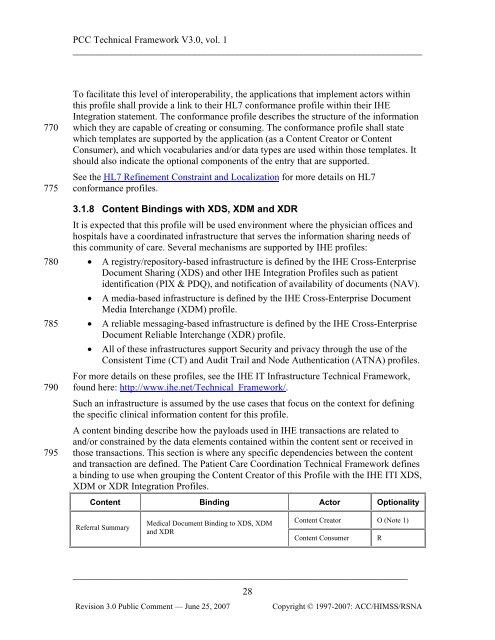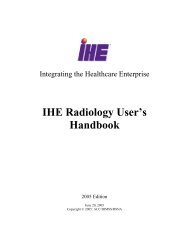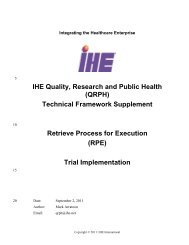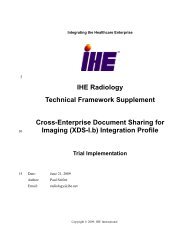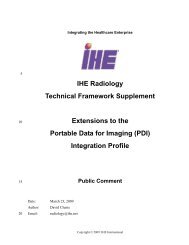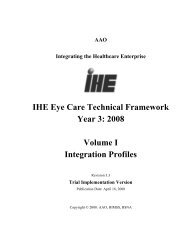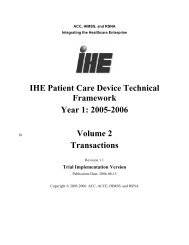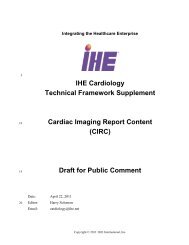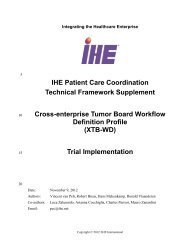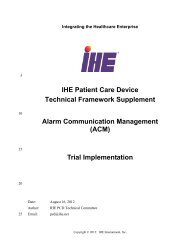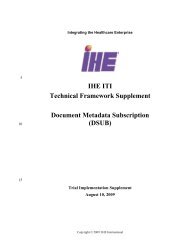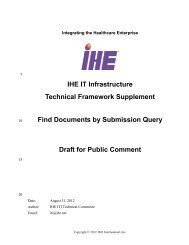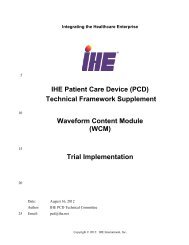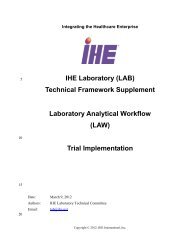IHE Patient Care Coordination Technical Framework Vol I
IHE Patient Care Coordination Technical Framework Vol I
IHE Patient Care Coordination Technical Framework Vol I
Create successful ePaper yourself
Turn your PDF publications into a flip-book with our unique Google optimized e-Paper software.
PCC <strong>Technical</strong> <strong>Framework</strong> V3.0, vol. 1<br />
________________________________________________________________________<br />
770<br />
775<br />
To facilitate this level of interoperability, the applications that implement actors within<br />
this profile shall provide a link to their HL7 conformance profile within their <strong>IHE</strong><br />
Integration statement. The conformance profile describes the structure of the information<br />
which they are capable of creating or consuming. The conformance profile shall state<br />
which templates are supported by the application (as a Content Creator or Content<br />
Consumer), and which vocabularies and/or data types are used within those templates. It<br />
should also indicate the optional components of the entry that are supported.<br />
See the HL7 Refinement Constraint and Localization for more details on HL7<br />
conformance profiles.<br />
3.1.8 Content Bindings with XDS, XDM and XDR<br />
780<br />
785<br />
790<br />
795<br />
It is expected that this profile will be used environment where the physician offices and<br />
hospitals have a coordinated infrastructure that serves the information sharing needs of<br />
this community of care. Several mechanisms are supported by <strong>IHE</strong> profiles:<br />
• A registry/repository-based infrastructure is defined by the <strong>IHE</strong> Cross-Enterprise<br />
Document Sharing (XDS) and other <strong>IHE</strong> Integration Profiles such as patient<br />
identification (PIX & PDQ), and notification of availability of documents (NAV).<br />
• A media-based infrastructure is defined by the <strong>IHE</strong> Cross-Enterprise Document<br />
Media Interchange (XDM) profile.<br />
• A reliable messaging-based infrastructure is defined by the <strong>IHE</strong> Cross-Enterprise<br />
Document Reliable Interchange (XDR) profile.<br />
• All of these infrastructures support Security and privacy through the use of the<br />
Consistent Time (CT) and Audit Trail and Node Authentication (ATNA) profiles.<br />
For more details on these profiles, see the <strong>IHE</strong> IT Infrastructure <strong>Technical</strong> <strong>Framework</strong>,<br />
found here: http://www.ihe.net/<strong>Technical</strong>_<strong>Framework</strong>/.<br />
Such an infrastructure is assumed by the use cases that focus on the context for defining<br />
the specific clinical information content for this profile.<br />
A content binding describe how the payloads used in <strong>IHE</strong> transactions are related to<br />
and/or constrained by the data elements contained within the content sent or received in<br />
those transactions. This section is where any specific dependencies between the content<br />
and transaction are defined. The <strong>Patient</strong> <strong>Care</strong> <strong>Coordination</strong> <strong>Technical</strong> <strong>Framework</strong> defines<br />
a binding to use when grouping the Content Creator of this Profile with the <strong>IHE</strong> ITI XDS,<br />
XDM or XDR Integration Profiles.<br />
Content Binding Actor Optionality<br />
Referral Summary<br />
Medical Document Binding to XDS, XDM<br />
and XDR<br />
Content Creator O (Note 1)<br />
Content Consumer<br />
R<br />
_____________________________________________________________________<br />
28<br />
Revision 3.0 Public Comment — June 25, 2007<br />
Copyright © 1997-2007: ACC/HIMSS/RSNA


